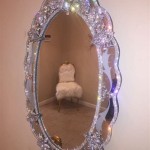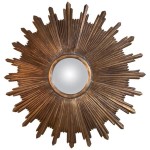How To Hang A Mirror Up On The Wall: A Comprehensive Guide
Hanging a mirror can significantly enhance the aesthetics of a room, providing a sense of spaciousness and reflecting light to brighten the environment. However, improper installation can lead to damage to the mirror, the wall, or even potential injury. This guide provides a step-by-step explanation on how to hang a mirror securely and correctly, taking into consideration various factors such as mirror weight, wall type, and appropriate hanging hardware.
Before proceeding, it's crucial to gather the necessary tools and materials. These commonly include a measuring tape, a level, a pencil, a stud finder, a drill, appropriate drill bits (for pilot holes and anchors), a hammer, wall anchors or screws, hanging hardware suitable for the mirror weight, safety glasses, and potentially a dust mask.
1. Assessing the Mirror and Wall
The first step involves thoroughly assessing the mirror itself. Examine the back of the mirror to determine the existing hanging hardware. Many mirrors come with pre-installed D-rings, wire, or keyhole slots. Understanding the existing hardware will dictate the type of wall anchors or screws needed for installation.
Measure the distance between the hanging points (e.g., D-rings). This measurement is critical for accurately marking the placement on the wall. Note the overall weight of the mirror. This information is essential for selecting appropriately rated hanging hardware. Exceeding the weight capacity of the hardware can lead to failure and potential damage.
Next, evaluate the wall. Determine the wall type: drywall, plaster, concrete, or wood paneling. Drywall is the most common wall type in residential construction, but it requires specific anchors to provide adequate support, especially for heavier mirrors. Solid wood walls offer the most secure anchoring points. Plaster walls can be brittle and may require special drilling techniques to prevent cracking. Concrete walls necessitate specialized drill bits and anchors designed for masonry.
Use a stud finder to locate wall studs. Wall studs are vertical wooden beams that provide the strongest support within the wall. If possible, anchoring the mirror directly into a stud is the most secure method. If studs are not in the desired location or if the mirror's hanging points do not align with stud placement, wall anchors are necessary.
If the wall is newly painted, allow adequate drying time, typically several days, as specified by the paint manufacturer. Hanging a mirror on wet paint can cause the paint to peel or adhere to the mirror, resulting in damage.
2. Choosing the Right Hanging Hardware
Selecting the correct hanging hardware is paramount for a secure and aesthetically pleasing installation. The choice depends primarily on the mirror's weight and the wall type.
For lightweight mirrors (under 10 pounds) hung on drywall, small picture-hanging hooks or self-adhesive strips specifically designed for mirrors may suffice. However, these options are generally not recommended for heavier mirrors or high-traffic areas where accidental bumps are likely.
For heavier mirrors hung on drywall, wall anchors are essential. Several types of drywall anchors are available, each with varying weight capacities. Plastic anchors are suitable for lighter loads, while metal anchors, such as toggle bolts and molly bolts, offer significantly higher weight capacities. Toggle bolts are particularly effective for distributing weight across a larger area of the drywall. Molly bolts expand behind the drywall as the screw is tightened, creating a secure hold.
When using wall anchors, ensure that the selected anchor's weight rating exceeds the mirror's weight by a significant margin. This provides a safety buffer and prevents the anchor from failing under stress. Always follow the manufacturer's instructions for installing wall anchors. Incorrect installation can compromise their holding power.
For concrete walls, use concrete screws or masonry anchors designed for this purpose. These anchors require specialized drill bits compatible with concrete. Drill pilot holes to the specified depth and insert the anchors according to the manufacturer's instructions.
For wood walls, screws are generally sufficient. Use screws of appropriate length and gauge to penetrate the wood studs deeply. Pre-drilling pilot holes is recommended to prevent the wood from splitting.
In addition to anchors, consider the type of hooks or hangers needed to connect the mirror to the wall. D-rings require compatible hooks or screws. Wire-hung mirrors can be hung on picture hooks or screws with a wide head to prevent the wire from slipping off. Keyhole slots require screws with a mushroom head that can be inserted into the slot and then slid down to lock the mirror in place.
3. Installation Procedure
Once the assessment is complete and the appropriate hardware is selected, the installation process can begin. First, determine the desired location for the mirror on the wall. Use a measuring tape to accurately mark the spot where the top of the mirror will be positioned. Use a level to ensure that the mirror will be hung straight.
If using wall anchors, mark the location of the anchor holes. Use a pencil to make small, precise marks. Refer to the anchor manufacturer's instructions for the correct hole size and spacing. Drill pilot holes using a drill bit appropriate for the wall type and the anchor size. Wear safety glasses to protect your eyes from debris.
Install the wall anchors into the pilot holes. Follow the manufacturer's instructions carefully. Some anchors require hammering into place, while others need to be screwed in. Ensure that the anchors are securely seated flush with the wall surface. If the wall is plaster, use a slow drilling speed and apply gentle pressure to prevent cracking. Consider using painter's tape over the drilling area to minimize chipping and cracking.
If anchoring into a wall stud, pre-drill pilot holes to prevent the wood from splitting. Use screws of appropriate length and gauge to penetrate the stud deeply. Avoid over-tightening the screws, as this can strip the threads and weaken the connection.
Attach the appropriate hooks or screws to the wall anchors or studs. Ensure that the hooks or screws are securely fastened and can support the weight of the mirror. If using screws, leave a small portion of the screw head exposed to allow the mirror's hanging hardware (e.g., D-rings, wire) to be attached.
Carefully lift the mirror and align the hanging hardware with the hooks or screws on the wall. Gently lower the mirror onto the hooks or screws. Check the mirror's alignment with a level. Make any necessary adjustments to ensure that the mirror is hanging straight.
Once the mirror is securely hung, double-check that it is stable and not wobbling. If the mirror is not hanging straight or if the hooks or screws appear to be under stress, remove the mirror and re-evaluate the installation. It may be necessary to use larger anchors or reposition the hanging hardware.
For large or heavy mirrors, it is highly recommended to have a second person assist with the installation process. This reduces the risk of dropping the mirror and causing damage or injury. Using moving blankets or padding to protect the mirror's surface during handling is also advisable.
After the mirror is securely installed, clean any dust or debris from the wall and the mirror's surface. Inspect the installation for any signs of weakness or instability. Periodically check the mirror's stability over time to ensure that the hanging hardware remains secure.
When dealing with older walls, especially those with plaster, exercise extra caution. Plaster can crumble easily, and old anchors may have weakened over time. Consider using a more robust anchoring system or consulting with a professional installer to ensure a secure and long-lasting installation.

How To Hang A Heavy Full Length Leaner Mirror On The Wall House Of Hepworths

How To Hang A Large Or Heavy Mirror

How To Hang A Mirror Perfectly

How To Hang A Heavy Full Length Leaner Mirror On The Wall House Of Hepworths

How To Hang A Heavy Full Length Leaner Mirror On The Wall Hanging Over Door

Easy For Hanging Mirrors And Frames Perfectly Every Time

How To Hang A Heavy Full Length Leaner Mirror On The Wall House Of Hepworths

How To Hang A Heavy Mirror C R F T

Easiest Way To Hang A Mirror

3 Simple Ways To Hang A Mirror On Wall Without Nails Wikihow








